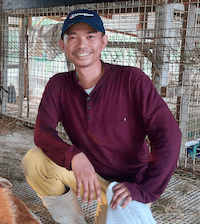Rice straw, also known as rice hay or “dayami,” is a valuable resource that you shouldn’t let go to waste. As a livestock farmer, you can maximize its potential in many ways. Let me share with you the top 10 ways you can use rice straw to benefit your farm.
- Feed Supplement for Ruminants If you have cattle, carabaos, or goats, rice straw can serve as a roughage source to aid in digestion. I know it’s not the most nutritious feed on its own, but you can improve its quality by treating it with urea or mixing it with molasses and legumes. Doing this will help you cut down on commercial feed costs while still keeping your animals well-fed.
- Bedding Material for Livestock I always recommend using dayami as bedding for cattle, pigs, and poultry. It provides a soft resting surface and absorbs moisture and waste, keeping your animals comfortable and cleaner. Plus, you can compost the used bedding and turn it into organic fertilizer, making your farm even more sustainable.
- Silage Production You can preserve rice straw by turning it into silage. Chop it up, mix it with molasses or urea, and store it in airtight conditions. This process enhances its digestibility and nutrient content, so you’ll have a more palatable feed for your animals, especially during feed scarcity.
- Mushroom Substrate If you’re looking to diversify your farm income, why not use rice straw for mushroom farming? Soak and sterilize it, then inoculate it with mushroom spores. You’ll have fresh mushrooms to sell or consume, making great use of this farm byproduct.
- Mulching Material I always tell farmers to use rice hay as mulch in their vegetable gardens and orchards. It helps retain soil moisture, suppress weeds, and regulate temperature. Over time, it decomposes and enriches the soil, benefiting both your plants and livestock.
- Organic Compost for Fertilizer Don’t throw away used rice straw—turn it into compost! Mix it with animal manure, and you’ll have a nutrient-rich fertilizer that improves soil structure and promotes microbial activity. This is a great way to reduce your reliance on chemical fertilizers.
- Alternative Fuel Source Did you know you can use dried rice straw as a biofuel for cooking and heating? I know farmers who use it for brick ovens, smokeless stoves, and even for drying crops. It’s a free and readily available energy source that can help you save on firewood expenses.
- Weed Control in Paddy Fields Instead of burning rice straw, use it to suppress weeds in your rice fields. Spread it over the soil, and it will limit weed germination, retain moisture, and improve soil health. This natural method reduces the need for herbicides, making your farming practices more eco-friendly.
- Handicrafts and Forage Binders If you’re into handicrafts, you can use rice straw to make mats, baskets, and decorative items. It’s also useful for weaving forage binders for baling hay and other feed materials. These simple yet practical applications can provide additional income for your farm.
- Erosion Control in Sloping Lands If your farm has sloping areas, spread rice straw to prevent soil erosion. It protects the soil from heavy rainfall, retains moisture, and helps keep your land stable. This is an easy and effective way to maintain soil fertility in sloping areas.
Top Signs of Quality Rice Straw
Not all rice straw is created equal. If you want the best for your farm, here are the key things to look for:
- Golden Yellow Color – High-quality rice straw should have a fresh, golden yellow color. A dull or grayish color could mean mold or excessive moisture exposure.
- Minimal Moisture Content – Choose dry rice straw to prevent mold and fungal contamination that could harm your livestock.
- Free from Mold and Foul Odors – Good rice straw should smell fresh or grassy. If it has a musty or sour odor, it’s probably spoiled.
- Free from Foreign Materials – Look for clean rice straw without dirt, plastic, or stones that could harm your animals.
- Uniform Texture and Length – Straw with a consistent length and texture is easier to handle for feeding, bedding, and composting.
- No Chemical Contamination – Make sure the rice straw comes from fields that weren’t sprayed heavily with herbicides or pesticides.
- Stored in a Dry and Well-Ventilated Area – Proper storage prevents spoilage and keeps your rice straw fresh for longer.
If you’re looking for high-quality rice straw, I recommend Alpha Agventure Farms. We ensure that our rice straw is properly dried, clean, and free from contaminants. Whether you need it for feeding, bedding, composting, or other farm uses, you can trust that we provide only the best. Contact Alpha Agventure Farms today and get the quality rice straw your farm deserves!

Mr. Jaycee de Guzman is a self-taught agriculturist and the founder and patriarch of Alpha Agventure Farms, recognized as the leading backyard farm in the Philippines. With a rich background in livestock farming dating back to the early 1990s, Mr. de Guzman combines his expertise in agriculture with over 20 years of experience in computer science, digital marketing, and finance. His diverse skill set and leadership have been instrumental in the success of Alpha Agventure Farms.


